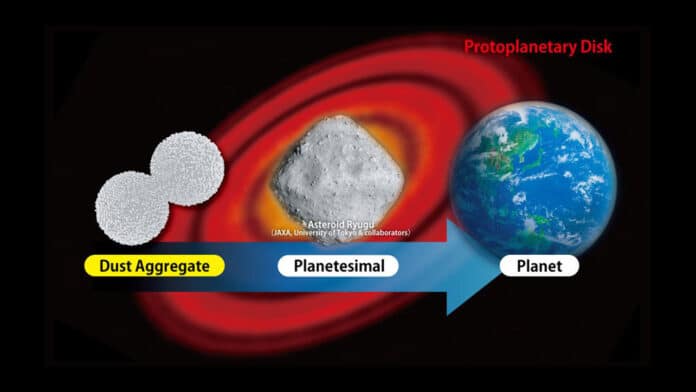Regarding planet formation, it is crucial to comprehend the collisional behavior of dust aggregates. When the filling factor of colliding dust aggregates is greater than a threshold value, it is known that low-velocity collisions of dust aggregates bounce rather than stick. A significant disparity between numerical and experimental results has been noted on the threshold filling factor.
Using soft-sphere discrete element techniques, a group of astrophysicists numerically simulated dust aggregate collisions with equal-mass aggregates ranging in size from 10,000 to 140,000 microns (one to 14 cm). Instead of treating the aggregate as a single entity, the discrete modeling approach took into account each particle inside it, and soft-sphere simulation assumed the rigidity of each particle within the aggregate while still allowing for deformations that may happen after a collision.
According to their simulation, the likelihood that two microparticle dust aggregates will stick together and become larger after colliding is reduced as the radius of the aggregates increases.
Hidekazu Tanaka, one of the authors of the study and professor at the Astronomical Institute in the Graduate School of Science at Tohoku University in Sendai, Japan, said, “The formation process of kilometer-sized bodies, planetesimals, from cosmic dust, which is the initial stage of planet formation, has been one of the biggest problems in the theory of planet formation.”
“The present study showed that the dust clumps that are the material for planets stop growing when they grow to a certain size, as large clumps are difficult to adhere to each other. Our results made the problem of planetesimal formation even more difficult. The adhesive growth of dust clumps is a key process in the planet-formation process.”
The simulations indicate that the production of planetesimals, or the nuclei of planets, would be inhibited by collisional bouncing between huge microparticle aggregates. Planets are created when planetesimals with a scale of a few kilometers collide and merge.
The research team and others speculated that different aggregate sizes were to blame for the inconsistent results frequently produced by earlier modeling simulations and laboratory tests determining the threshold for the sticking/bouncing barrier of dust aggregate impacts. The current study’s findings support this notion.
The reason aggregate size influences the likelihood of adhering during a collision is still unknown. Scientists may be able to grasp better how aggregates can resemble planetesimals through the analysis of aggregate packing structures in the future. Studies of the contact points between aggregates following a collision, where most energy is lost, may also reveal how larger aggregates ultimately cling to one another.
Additionally, the simulations carried out by the study team imply that the sticking likelihood of particle aggregates may be influenced not only by the radius of the overall aggregate but also by the size of the individual particles that make up the aggregate.
The team knows the simulations they ran for this investigation are not exhaustive. The model will be improved by laboratory trials and simulations incorporating aggregates that can be prepared using realistic methods and that address acceleration.
Beyond these simulations, the team has its sights set on larger aggregates, which may fundamentally change current theories of planet development.
Tanaka said, “We will use a supercomputer to perform large-scale numerical simulations of collisions between even larger dust clumps to investigate how difficult it is for large dust clumps to attach. This will help to settle the question of whether the formation of planetesimals is possible through the adhesion of dust clumps.”
Journal Reference:
- Sota Arakawa, Satoshi Okuzumi, Misako Tatsuuma, Hidekazu Tanaka, Eiichiro Kokubo, Daisuke Nishiura, Mikito Furuichi, Taishi Nakamoto. Size Dependence of the Bouncing Barrier in Protoplanetary Dust Growth. The Astrophysical Journal Letters. DOI: 10.3847/2041-8213/acdb5f
